CDN - the new standard for video broadcasting
On April 25, the world premiere of the 6th season of the game “Game of Thrones” took place. Together with the rest of the world, the continuation of the cult saga became available to MegaFon.TV viewers. The expected surge in audience interest is a serious test for the MegaFon network, which will deliver terabytes of video content to subscribers without losing quality. For the solution of this extremely difficult task meets its own solution CDN. How to show a high-quality film on the Internet and discourage users from using torrents - this is what the company’s representatives Alexey Sechkin and Evgeny Denisov say.

The release of “hot” new products like the next season of “Game of Thrones” and the ability to watch them legally via the Internet in HD quality - all this indicates a significant qualitative leap that the Russian online broadcasting market has made in recent years. He firmly got on his feet, found his users and follows global trends, the main of which are the legality of the content and the ability to watch it from any device in high quality without resorting to downloading to media.
This is confirmed by the figures: according to research by iKS-Consulting, the Russian online video market has become the largest in Europe, and the number of unique viewers of Russian licensed video services has reached 60 million. The growth of legal video services in Runet continues, and the arrival of Netflix, the world leader in VoD, in Russia is another confirmation of this.
And although not all Russian users agree to part with the freebie video from torrents, nevertheless the number of people is decreasing. And there are objective reasons for this - the development of gadgets, mobile Internet and, of course, the active fight against pirated content by copyright holders and the regulator.
General Director of the Association “Internet Video” Alexei Byrdin :
All this suggests that the volume of video traffic will only increase, which means that the problem of its delivery to the end user will be more relevant.
Taking into account global and Russian trends, the problem of the technical readiness of the networks of Russian operators to miss large volumes of traffic is becoming increasingly acute.
Video delivery without using a distributed network implies a powerful source server and a wide Internet channel to it. However, with an increase in the number of requests, there is a risk of channel or server overload.
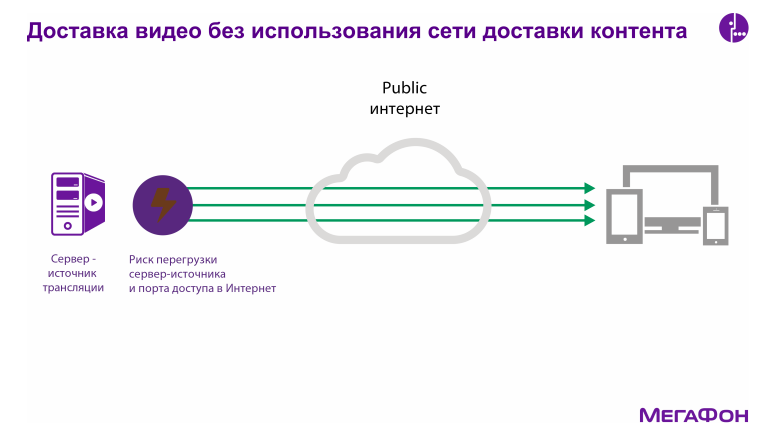
There can be no compromise for the viewer: either you provide high-definition traffic, without “glitches”, buffering and scattering on pixels, or you don’t do it at all. This can be achieved only with the help of a distributed content delivery network - either your own or outsourced.
Until recently, the question of which decision to choose a video broadcaster - whether it’s own or rented - was practically not raised. Almost all major content providers developed their own solution on their infrastructure (some continue to do so until now).
However, in the case of developing the infrastructure of its own network, additional costs arose for its creation and support.

Recently, the situation has changed. Firstly, the acquisition of foreign network equipment along with a jump in the exchange rate has become an expensive investment. Secondly, traffic and viewing geography are growing explosively, and the equipment purchase cycle, which can last up to six months, may simply not be in time for them. Therefore, now even top-end video broadcasters use the CDN service or transfer to this network, at least, tasks for broadcasting peak events.
Using CDNs, video broadcasters reduce costs on the one hand, and on the other, significantly expand coverage and improve broadcast quality.
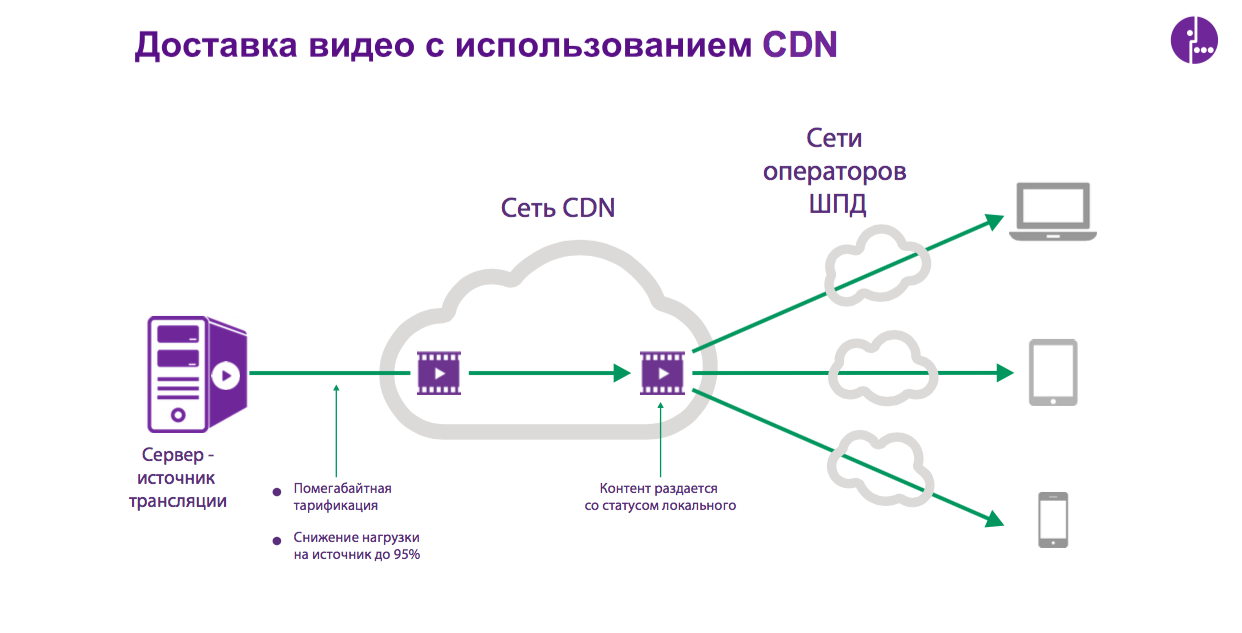
Due to CDN, investments in the network can be reduced by an order of magnitude.

There are two types of video content delivery: Broadcasting and video download on demand (VOD - Video on Demand).
In the case of streaming broadcasting, which is a continuous broadcast in real time, the CDN network takes the video stream from the source (server, camera, software), processes it in various formats, multiplies and delivers it to the user’s player from the nearest CDN.
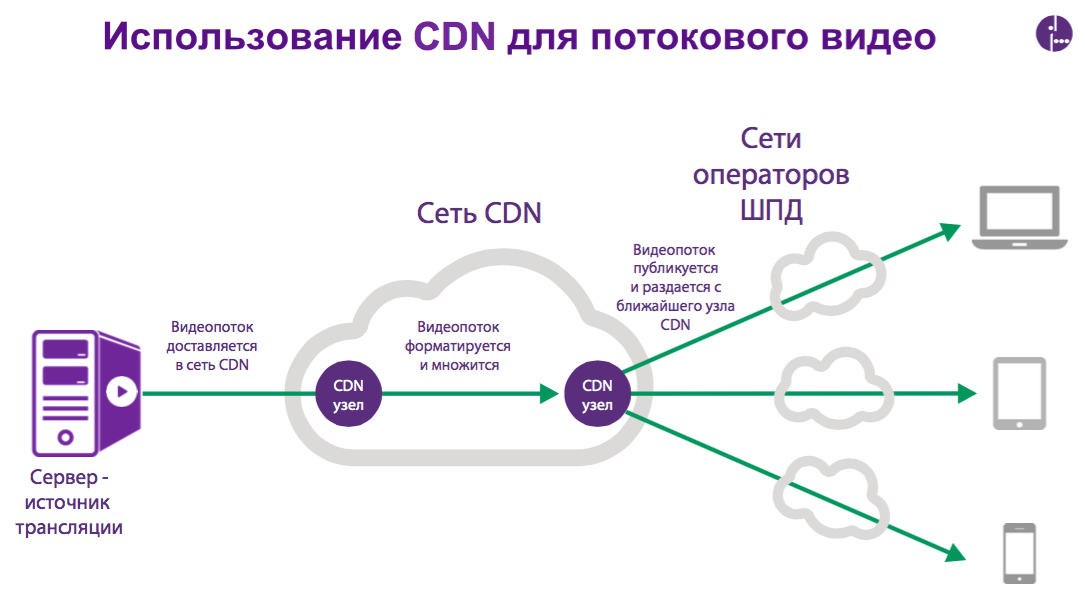
To display video on demand via CDN, the requested static file is loaded into the cache of the CDN nodes and is also sent to the subscriber’s device from the nearest server.
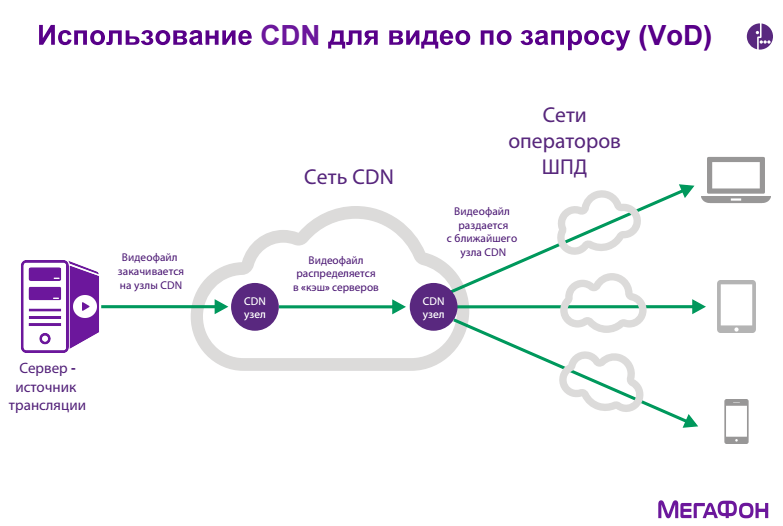
It is a mistake to believe that it is advisable to use only large media resources to deliver your CDN service. The reality is that a CDN will be in demand for any video, in case it needs to be delivered to users located in another region or even a city.
MegaFon company not only offers CDN service in the market, but, of course, actively uses it in its media projects. Therefore, we have a great opportunity to show the effect of using CDN for broadcasting video content using our own case studies.
In 2015, TV content was broadcast via CDN as part of the WiFire project of MegaFon's subsidiary NetByNet. Following the results of several months, the following results were recorded.
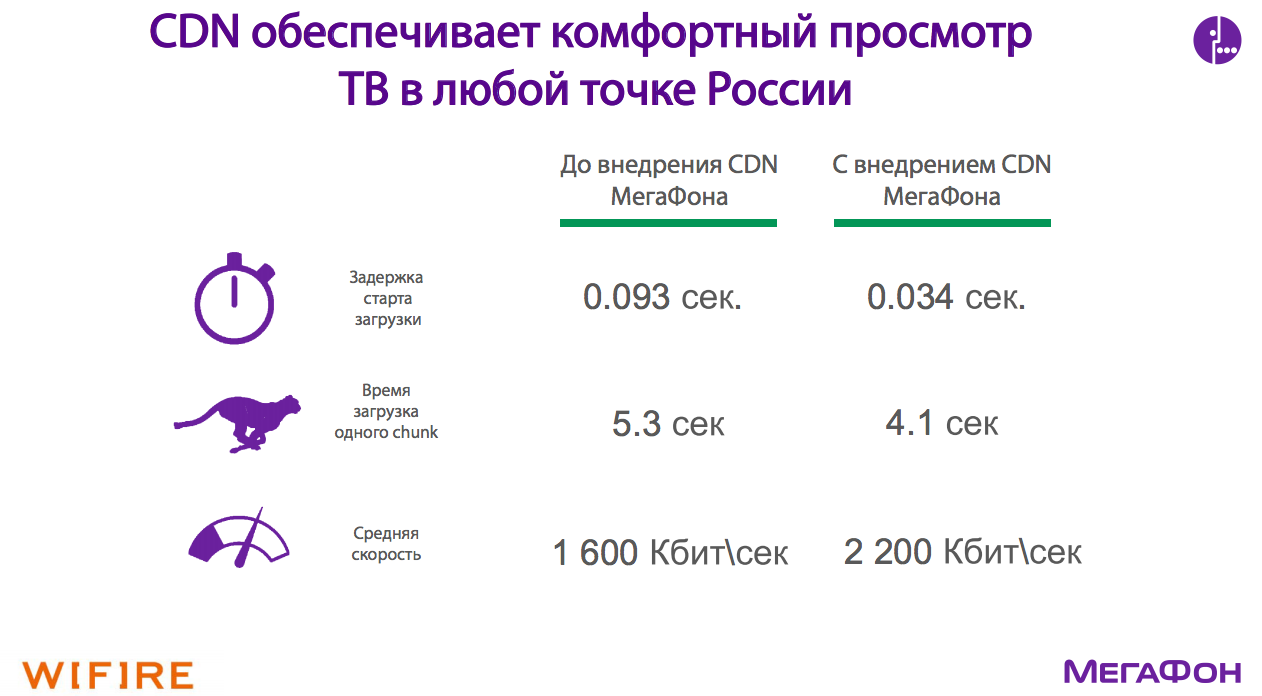
Also in 2015, the updated MegaFon.TV service was introduced, which immediately fell onto the tracks of CDN. Within literally six months, the service gained popularity, which was reflected in the growth of the subscriber base and the volume of downloaded traffic. In April 2016, CDN sent 1,242 Terabytes of video to MegaFon subscribers. In January, the service withstood the traditional increased load, which fell on December 31 - January 1, when it was downloaded about 67 Terabytes.

Successfully coping with the growing volume of downloaded traffic, the service attracted new viewers. In April, the number of unique viewers per hour was almost 60 thousand people a day. On New Year's days, December 31 - January 1, the number of unique visitors amounted to 273 thousand people.
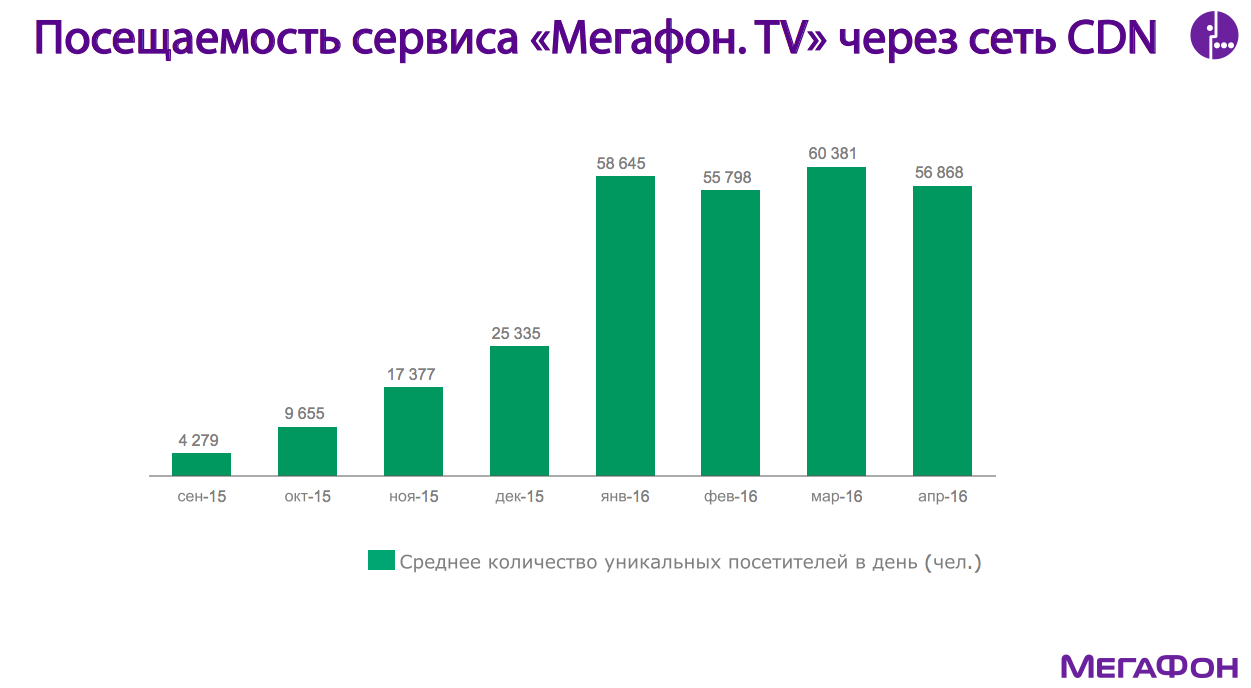
The show of the first episode of the 6th season, “Game of Thrones”, at once broke records on attendance and downloaded traffic of MegaFon.TV on the CDN network. In the first two days after the premiere (April 24, 25) the number of unique visitors amounted to 427 thousand people, i.e. more than one and a half times more than for the New Year. The volume of downloaded traffic was 126 terabytes, i.e. 2 times more than in the New Year.
The practice of MegaFon shows that CDN technology, if not directly, then significantly affects such key KPI video resources as attendance of broadcasts, traffic, broadcasting efficiency of top events. CDN allows you to successfully withstand the peaks of the spectator surge during top events, when the load increases 10-15 times. But new tests are yet to come - for 2016, another record of viewer interest in Internet broadcasts is forecasted - during the European Football Championship and Olympics.
MegaFon.TV and CDN MegaFon are ready for this. What about your video resource?

Online video in Russia and in the world
The release of “hot” new products like the next season of “Game of Thrones” and the ability to watch them legally via the Internet in HD quality - all this indicates a significant qualitative leap that the Russian online broadcasting market has made in recent years. He firmly got on his feet, found his users and follows global trends, the main of which are the legality of the content and the ability to watch it from any device in high quality without resorting to downloading to media.
This is confirmed by the figures: according to research by iKS-Consulting, the Russian online video market has become the largest in Europe, and the number of unique viewers of Russian licensed video services has reached 60 million. The growth of legal video services in Runet continues, and the arrival of Netflix, the world leader in VoD, in Russia is another confirmation of this.
And although not all Russian users agree to part with the freebie video from torrents, nevertheless the number of people is decreasing. And there are objective reasons for this - the development of gadgets, mobile Internet and, of course, the active fight against pirated content by copyright holders and the regulator.
General Director of the Association “Internet Video” Alexei Byrdin :
In the heyday of the DVD market, which was undoubtedly paid (and people paid for pirated and legal discs with real money), its income amounted to $ 3 billion. In 2014, the entire market for legal online distribution of content brought about 125 billion rubles, that is, about $ 2 billion at the current rate. So, the talk that our users are not ready to pay for anything is a myth that is being diligently distributed by pirates and circulated by the media.CISCO in its report “Visual Network Technology Development Index” predicts a 6-fold increase in video traffic from 2014 to 2019. The main drivers of video content growth in Russia and in the world now are such technical advances as, for example, ultra-high-resolution video. By 2019, the share of HD and Ultra HD will grow to 70%. For comparison, in 2014 the share was 34%. Already, it is clear that in the near future, a new impetus will be given to growth by spherical and circular video technologies, as well as virtual reality platforms.
All this suggests that the volume of video traffic will only increase, which means that the problem of its delivery to the end user will be more relevant.
Build a network or not?
Taking into account global and Russian trends, the problem of the technical readiness of the networks of Russian operators to miss large volumes of traffic is becoming increasingly acute.
Video delivery without using a distributed network implies a powerful source server and a wide Internet channel to it. However, with an increase in the number of requests, there is a risk of channel or server overload.

There can be no compromise for the viewer: either you provide high-definition traffic, without “glitches”, buffering and scattering on pixels, or you don’t do it at all. This can be achieved only with the help of a distributed content delivery network - either your own or outsourced.
Until recently, the question of which decision to choose a video broadcaster - whether it’s own or rented - was practically not raised. Almost all major content providers developed their own solution on their infrastructure (some continue to do so until now).
However, in the case of developing the infrastructure of its own network, additional costs arose for its creation and support.

Recently, the situation has changed. Firstly, the acquisition of foreign network equipment along with a jump in the exchange rate has become an expensive investment. Secondly, traffic and viewing geography are growing explosively, and the equipment purchase cycle, which can last up to six months, may simply not be in time for them. Therefore, now even top-end video broadcasters use the CDN service or transfer to this network, at least, tasks for broadcasting peak events.
Using CDNs, video broadcasters reduce costs on the one hand, and on the other, significantly expand coverage and improve broadcast quality.

Due to CDN, investments in the network can be reduced by an order of magnitude.

How video content is delivered via CDN
There are two types of video content delivery: Broadcasting and video download on demand (VOD - Video on Demand).
In the case of streaming broadcasting, which is a continuous broadcast in real time, the CDN network takes the video stream from the source (server, camera, software), processes it in various formats, multiplies and delivers it to the user’s player from the nearest CDN.

To display video on demand via CDN, the requested static file is loaded into the cache of the CDN nodes and is also sent to the subscriber’s device from the nearest server.

It is a mistake to believe that it is advisable to use only large media resources to deliver your CDN service. The reality is that a CDN will be in demand for any video, in case it needs to be delivered to users located in another region or even a city.
Use of CDN in MegaFon projects
MegaFon company not only offers CDN service in the market, but, of course, actively uses it in its media projects. Therefore, we have a great opportunity to show the effect of using CDN for broadcasting video content using our own case studies.
In 2015, TV content was broadcast via CDN as part of the WiFire project of MegaFon's subsidiary NetByNet. Following the results of several months, the following results were recorded.

Also in 2015, the updated MegaFon.TV service was introduced, which immediately fell onto the tracks of CDN. Within literally six months, the service gained popularity, which was reflected in the growth of the subscriber base and the volume of downloaded traffic. In April 2016, CDN sent 1,242 Terabytes of video to MegaFon subscribers. In January, the service withstood the traditional increased load, which fell on December 31 - January 1, when it was downloaded about 67 Terabytes.

Successfully coping with the growing volume of downloaded traffic, the service attracted new viewers. In April, the number of unique viewers per hour was almost 60 thousand people a day. On New Year's days, December 31 - January 1, the number of unique visitors amounted to 273 thousand people.

The show of the first episode of the 6th season, “Game of Thrones”, at once broke records on attendance and downloaded traffic of MegaFon.TV on the CDN network. In the first two days after the premiere (April 24, 25) the number of unique visitors amounted to 427 thousand people, i.e. more than one and a half times more than for the New Year. The volume of downloaded traffic was 126 terabytes, i.e. 2 times more than in the New Year.
The practice of MegaFon shows that CDN technology, if not directly, then significantly affects such key KPI video resources as attendance of broadcasts, traffic, broadcasting efficiency of top events. CDN allows you to successfully withstand the peaks of the spectator surge during top events, when the load increases 10-15 times. But new tests are yet to come - for 2016, another record of viewer interest in Internet broadcasts is forecasted - during the European Football Championship and Olympics.
MegaFon.TV and CDN MegaFon are ready for this. What about your video resource?
